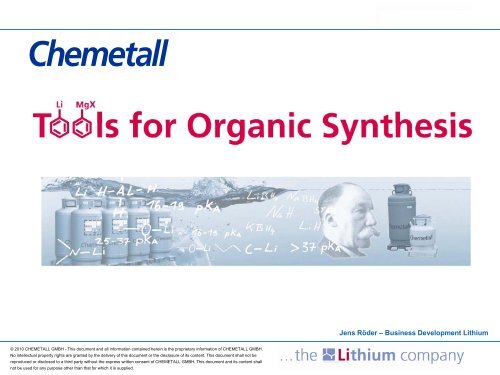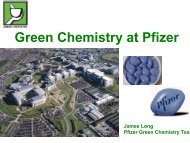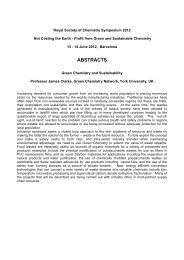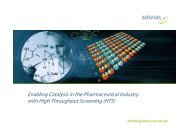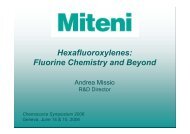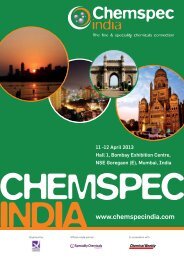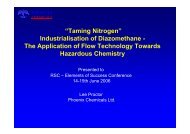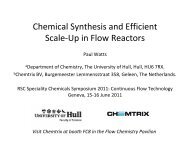New Reagents for Lithium Assisted ... - Chemspec Events
New Reagents for Lithium Assisted ... - Chemspec Events
New Reagents for Lithium Assisted ... - Chemspec Events
Create successful ePaper yourself
Turn your PDF publications into a flip-book with our unique Google optimized e-Paper software.
Jens Röder – Business Development <strong>Lithium</strong><br />
© 2010 CHEMETALL GMBH - This document and all in<strong>for</strong>mation contained herein is the proprietary in<strong>for</strong>mation of CHEMETALL GMBH.<br />
No intellectual property rights are granted by the delivery of this document or the disclosure of its content. This document shall not be<br />
reproduced or disclosed to a third party without the express written consent of CHEMETALL GMBH. This document and its content shall<br />
not be used <strong>for</strong> any purpose other than that <strong>for</strong> which it is supplied.
• Chemetall – The <strong>Lithium</strong> Company<br />
• <strong>New</strong> <strong>Reagents</strong> <strong>for</strong> <strong>Lithium</strong> <strong>Assisted</strong> Addition<br />
and Deprotonation Reactions:<br />
- Improving Grignard-addition reactions -<br />
LaCl 3 x LiCl<br />
- Li-powered metalation reactions - <strong>New</strong><br />
Mg- and Zn-amide bases<br />
2
Group Structure 2008<br />
Net Sales: $ 3.380<br />
Employees: 10.000<br />
Specialty<br />
Chemicals<br />
(Chemetall)<br />
Pigments &<br />
Additivs<br />
Advanced<br />
Materials<br />
Net Sales: $ 1.233 Net Sales: $ 1.370 Net Sales: $ 767<br />
Rockwood – Global specialty chemicals and advanced materials company<br />
3
Chemetall Group – At a glance 2008<br />
1923 <strong>Lithium</strong> operations<br />
started by Metallgesellschaft<br />
1992 Dynamit Nobel-Group<br />
1998 Acquisition Foote Corp.<br />
2004 Rockwood Holdings<br />
Chemetall-Group<br />
Sales: 847 million €<br />
Employees: 3008<br />
Subsidiaries: More than 40<br />
Production sites: 33<br />
Fine Chemicals<br />
Surface<br />
Treatment<br />
• <strong>Lithium</strong><br />
• Special Metals<br />
• Metal Sulphides<br />
• Automotive<br />
Technologies<br />
• Advanced<br />
Technologies<br />
• Per<strong>for</strong>mance<br />
Products<br />
• System<br />
Technologies<br />
4<br />
4
Chemetall <strong>Lithium</strong> - Manufacturing Sites<br />
La Porte, TX, USA<br />
<strong>New</strong> Johnsonville, TN, USA<br />
Langelsheim, Germany<br />
Silver Peak, NV, USA<br />
Taichung, Taiwan<br />
Antofagasta, Chile<br />
Kings Mountain, NC, USA<br />
5
<strong>Lithium</strong> – Selected Applications<br />
Key Products<br />
Key Applications<br />
<strong>Lithium</strong><br />
carbonate<br />
Li-Ionen-Batteries<br />
Glass ceramics<br />
Cement<br />
Aluminum<br />
<strong>Lithium</strong><br />
hydroxide<br />
Li-Ionen-Batterien<br />
Grease<br />
CO 2<br />
Absorption<br />
Mining<br />
<strong>Lithium</strong><br />
metal<br />
<strong>Lithium</strong> Batteries<br />
Pharmaceuticals<br />
Al - alloys<br />
Butyllithium<br />
Elastomers<br />
Pharmaceuticals<br />
Agrochemicals<br />
<strong>Lithium</strong><br />
specialties<br />
Electronic Materials<br />
Pharmaceuticals<br />
Agrochemicals<br />
6<br />
6
The “<strong>Lithium</strong> Tree”<br />
Li-Acetylide<br />
Li-<br />
Peroxide<br />
LiBOB<br />
Li-<br />
Perchlorate<br />
Li-<br />
Iodide<br />
Methyllithium<br />
Phenyllithium<br />
Li-t-<br />
Butoxide<br />
Li-<br />
Methoxide<br />
LDA<br />
LHS<br />
<strong>Lithium</strong><br />
Metal<br />
Li-<br />
Hydride<br />
Li-tri<br />
(t-butoxy)-<br />
alanate<br />
Butyllithium<br />
Li-<br />
Alanate<br />
Li-Tetraborate<br />
Li-<br />
Nitride<br />
Li-<br />
Amide<br />
Sabalith<br />
Li-<br />
Silicate<br />
Li-<br />
Phosphate<br />
Comments<br />
• Providing lithium compounds<br />
throughout all stages of the<br />
value chain<br />
• Constant expansion due to<br />
new applications<br />
• Optimization according to<br />
customer needs<br />
Li-<br />
Salicylate<br />
Li-<br />
Fluoride<br />
Foils<br />
<strong>Lithium</strong><br />
Chloride<br />
Li-<br />
Nitrate<br />
Li-<br />
Citrate<br />
Li-<br />
Benzoate<br />
Li-<br />
Acetate<br />
Li-<br />
Bromide<br />
Li-<br />
Hydroxide<br />
Anodes<br />
<strong>Lithium</strong><br />
Carbonate<br />
Li-<br />
Zeolite<br />
Li-<br />
Sulphate<br />
STB<br />
STA STAB MTB<br />
Sodium<br />
Compounds<br />
R-Zn-X<br />
Grignards<br />
Magnesium<br />
Compounds<br />
MDA<br />
Potash<br />
CO2-<br />
Absorption<br />
Products<br />
Brines<br />
Bischofite<br />
Know<br />
How<br />
7
Application Areas<br />
8
1,2-Addition Reactions with R-MgX<br />
Most Grignard products are used <strong>for</strong> 1,2-addition reactions to carbonyl compounds:<br />
OMgX<br />
R 2 R 3<br />
O<br />
R 2<br />
R 3<br />
R 1 MgX<br />
OMgX<br />
R 2 +<br />
R 3<br />
R 1<br />
enolisation<br />
OMgX<br />
side<br />
reactions<br />
R 2 R 3<br />
reduction<br />
Especially when bulky groups are present in the molecule side reactions take place<br />
which<br />
• lead to lower yields<br />
• require extensive purification of the product<br />
• sometimes inhibit the desired reaction<br />
9
Soluble Lanthanoide Halides - LiCl Complexes<br />
Reducing <strong>for</strong>mation of by-products by Lewis-acid activation of the ketone:<br />
State State of of the theart art solution solutionisisthe theuse useof<br />
of<br />
water waterfree freeCe Ce (III) (III) salts salts (Imamoto (Imamoto<br />
method) method)<br />
-Low -Low solubility solubilityof of CeCl CeCl 3 in process<br />
3 in process<br />
solvent solvent THF THF (0.6 (0.6 weight%) weight%) results results<br />
in in inhomogeneous inhomogeneousreaction<br />
mixtures mixtures<br />
-Handling -Handling of of highly highlyhygroscopic<br />
hygroscopic<br />
CeCl CeCl 3 3<br />
-Only -Onlyspecial specialgrades (pretreatment)<br />
(pretreatment)<br />
CeCl CeCl 3 result in good results<br />
3 result in good results<br />
Improved ImprovedChemetall solution solutionisisthe<br />
the<br />
use useof of LaCl LaCl 3 LiCl solution in<br />
3 x 2 LiCl solution in<br />
THF THF<br />
+ High High solubility solubilityof of LaCl LaCl 3 due to<br />
3 due to<br />
addition additionof of LiCl LiCl<br />
+ Ready Readyto to use useproduct<br />
+ Easy Easy handling handlingand and dosing dosing<br />
+ Low Low water watercontent<br />
+ Lots Lots of of examples examplesdescribed describedin in the the<br />
literature literature<br />
10
LaCl 3 x LiCl - Examples<br />
O<br />
+<br />
MgCl<br />
OH<br />
without additive<br />
CeCl 3 (Imamoto, Dimitriov)<br />
LnCl 3 *2 LiCl<br />
3-5%<br />
80%<br />
>90%<br />
O<br />
+<br />
MgCl*LiCl<br />
OH<br />
Ln = La, Ce, Nd<br />
Ln = La, Ce, Nd<br />
without additive<br />
CeCl 3 (Imamoto, Dimitriov)<br />
LnCl 3 *2 LiCl<br />
4%<br />
-<br />
> 90%<br />
O<br />
+<br />
MgCl<br />
OH<br />
without additive<br />
CeCl 3 (Imamoto, Dimitriov)<br />
LnCl 3 *2 LiCl<br />
21%<br />
-<br />
> 90%<br />
A. Krasovskiy, P. Knochel, Angew. Chem. Int. Ed. 2006, 45,497-500.<br />
11
LaCl 3<br />
x LiCl - Influence of Stoichiometry<br />
MgBr·LiCl<br />
+<br />
Ph<br />
O<br />
Me<br />
Ph HO Me<br />
without additive: 33 %<br />
LaCl 3<br />
.<br />
2 LiCl (30 mol%) 87 %<br />
LaCl 3 . 2 LiCl (100 mol%) 93 %<br />
O<br />
i-PrMgCl + Ph Ph<br />
Ph<br />
OH<br />
Ph<br />
without additive: 3 %<br />
LaCl 3<br />
.<br />
2 LiCl (30 mol%) 65 %<br />
LaCl 3 . 2 LiCl (100 mol%) 86 %<br />
A. Metzger, G. Gavryushin, P. Knochel, Synlett, 2009, 9, 1433<br />
12
LaCl 3<br />
x LiCl – Synthesis of Tryptamines<br />
N<br />
Boc<br />
MeO<br />
OMe<br />
I<br />
Boc<br />
N<br />
Me<br />
1. iPrMgCl . LiCl;<br />
2. LaCl . 3 2LiCl;<br />
OH<br />
O<br />
Boc<br />
3. MeO<br />
N<br />
N Boc<br />
OMe Me<br />
without isolation of intermediates<br />
78%<br />
NH 2<br />
“An “An expedient strategy <strong>for</strong> <strong>for</strong> the the synthesis of of<br />
tryptamines and and other other heterocycles…”<br />
MeO<br />
OMe<br />
N<br />
Me<br />
key intermediate <strong>for</strong> aspidophytine<br />
K. C. Nicolaou et al, Angew. Chem. Int. Ed 2008, 47, 4217.<br />
13
LaCl 3<br />
x LiCl – Industrial Interest<br />
Challenge:<br />
Suppression of side products generated by<br />
enolization of ketone intermediate<br />
Cl<br />
N<br />
OH<br />
O<br />
O<br />
R<br />
Method<br />
Method<br />
A:<br />
A:<br />
1<br />
1<br />
equiv.<br />
equiv.<br />
anhydrous<br />
anhydrous<br />
CeCl<br />
CeCl 3 3<br />
•<br />
•<br />
Special<br />
Special<br />
two<br />
two<br />
step<br />
step<br />
drying<br />
drying<br />
method<br />
method<br />
is<br />
is<br />
essential<br />
essential<br />
•<br />
•<br />
Special<br />
Special<br />
crystal<br />
crystal<br />
habit<br />
habit<br />
of<br />
of<br />
CeCl<br />
CeCl 3<br />
is critical<br />
3<br />
is critical<br />
•<br />
•<br />
Tedious<br />
Tedious<br />
activation<br />
activation<br />
method<br />
method<br />
is<br />
is<br />
required<br />
required<br />
•<br />
•<br />
Low<br />
Low<br />
solubility<br />
solubility<br />
results<br />
results<br />
in<br />
in<br />
heterogenous<br />
heterogenous<br />
reaction<br />
reaction<br />
mixture<br />
mixture<br />
Adv.<br />
Adv.<br />
Synth.<br />
Synth.<br />
Catal.<br />
Catal.<br />
2004,<br />
2004,<br />
346,<br />
346,<br />
1307<br />
1307<br />
Cl<br />
CH 3 -MgCl (5 equiv.)<br />
N<br />
OH<br />
HO CH 3<br />
CH 3<br />
Method<br />
Method<br />
B:<br />
B:<br />
LaCl<br />
LaCl 3<br />
*2 LiCl – THF solution<br />
3<br />
*2 LiCl – THF solution<br />
•<br />
•<br />
Highly<br />
Highly<br />
soluble,<br />
soluble,<br />
homogenous<br />
homogenous<br />
reaction<br />
reaction<br />
conditions<br />
conditions<br />
•<br />
•<br />
Water-free<br />
Water-free<br />
product<br />
product<br />
•<br />
•<br />
Lower<br />
Lower<br />
LaCl<br />
LaCl 3<br />
/ester ratios possible:<br />
3<br />
/ester ratios possible:<br />
1.0<br />
1.0<br />
equiv.<br />
equiv.<br />
LaCl<br />
LaCl 3<br />
: 94,9% yield<br />
3<br />
: 94,9% yield<br />
0.5<br />
0.5<br />
equiv.<br />
equiv.<br />
LaCl<br />
LaCl 3<br />
: 88,3% yield<br />
3<br />
: 88,3% yield<br />
EP<br />
EP<br />
2<br />
2<br />
014<br />
014<br />
633<br />
633<br />
(Lonza<br />
(Lonza<br />
AG)<br />
AG)<br />
key intermediate in the synthesis of Montelukast<br />
14
Application Areas<br />
15
Directed ortho-Metalation (DOM) Reactions<br />
DG<br />
DG<br />
DG<br />
FG<br />
H<br />
Base<br />
FG<br />
M<br />
E +<br />
FG<br />
E<br />
DG = directing group<br />
FG = functional group<br />
Base= e.g. BuLi, LDA, MDA or other<br />
M = Li (BuLi, TMPLi, LDA ..)<br />
• High reactivity<br />
• Low functional group tolerance<br />
M = Mg, Zn<br />
• Lower reactivity<br />
• Higher selectivity and functional<br />
group tolerance<br />
16
Hauser Base with LiCl<br />
N<br />
MgCl/LiCl<br />
(TMP- MgCl/LiCl)<br />
• the combination of Mg and Li increases the deprotonation<br />
power<br />
• nevertheless selectivity and functional group tolerance remain<br />
at a high level<br />
• reagent exhibts excellent solubility and stability in THF<br />
17
TMP-MgCl x LiCl – Crystal Structure<br />
Source of powerful magnesiating ability:<br />
• active basic ligand binds to Mg (not to Li)<br />
• four-coordinate Mg center is coordinatively saturated, but has a labile<br />
THF ligand geminal to TMPH<br />
• bimetallic, ate („Li + MgR 3-<br />
) constitution could be a key factor <strong>for</strong> the<br />
enhanced magnesiating ability<br />
P. Garcia-Alvarez, R. E. Mulvey, Angew. Chem.Int. Ed. 2008, 47, 8079-8081.<br />
18
TMP-MgCl x LiCl - Examples<br />
high functional group<br />
tolerance…<br />
DG<br />
DG<br />
H<br />
MgCl/LiCl<br />
TMPMgCl/LiCl<br />
FG<br />
FG<br />
DG = OBoc, CO 2 R, COR.....<br />
FG = CO 2 R, CN, COR,.... not FG = CHO, NO 2<br />
LDA<br />
THF, -78 °C<br />
Br<br />
Li<br />
Br<br />
Br<br />
Br<br />
N<br />
…different selectivity<br />
N<br />
Br<br />
Br<br />
TMPMgCl . LiCl (1.1 eq)<br />
THF, -25°C<br />
N<br />
MgCl . LiCl<br />
19
TMP-MgCl x LiCl – Synthesis of Talnetant<br />
CO 2 Et<br />
1) TMPMgCl/LiCl<br />
-10 °C, 3 h<br />
2)<br />
O<br />
B<br />
O<br />
OEt<br />
CO 2 Et<br />
B<br />
R R<br />
N<br />
92 %<br />
Br<br />
3) HCl, Et 2<br />
O<br />
N<br />
71 %<br />
Br<br />
1) iPrMgCl/LiCl<br />
-78°C,2h<br />
2) NC-CO 2 Et<br />
-78 °C to rt, 12 h<br />
Br<br />
O<br />
Ph<br />
NH<br />
Et<br />
OH<br />
N<br />
N<br />
Br<br />
Nadege Boudet, P. Knochel, Org. Lett., 2007,9, 5525-5528.<br />
under research <strong>for</strong> treatment of schizophrenia<br />
and as potential antipsychotic<br />
20
TMP-MgCl x LiCl – Hexasubstituted Benzene<br />
Multiple functionalization of 3-chlorobenzoate by successive magnesations:<br />
CO 2 Et<br />
1) TMPMgCl LiCl<br />
1,2equiv,0°C,6h<br />
CO 2 Et<br />
CN<br />
1) TMPMgCl LiCl<br />
1,5equiv,-20°C,5h<br />
CO 2 Et<br />
CO 2 Et<br />
CN<br />
Cl<br />
2) TsCN<br />
Cl<br />
2) EtOCOCN<br />
Cl<br />
76%<br />
60%<br />
1) TMPMgCl LiCl<br />
1,2 equiv, -50 °C to -30 °C,<br />
30 min<br />
CO 2 Et<br />
CO 2<br />
Et<br />
CN<br />
1) TMPMgCl LiCl<br />
1,2equiv,-50°C,1.5h<br />
CO 2 Et<br />
CO 2<br />
Et<br />
CN<br />
2) ZnCl 2<br />
3) Pd(PPh 3 ) 4 (2 mol%)<br />
ElOCOCl (1.5 equiv)<br />
CO 2<br />
Et<br />
83%<br />
Cl<br />
2) an electrophile<br />
CO 2<br />
Et<br />
E<br />
Cl<br />
W. Lin, O. Baron, P. Knochel, Org. Lett. 2006, 8, 5673 - 5676<br />
21
TMP-MgCl x LiCl – Magnesation of Chloropyrimidines<br />
Lithiation of pyrimidines is difficult due to high reactivity of the ring<br />
towards addition reactions there<strong>for</strong>e requiring low temperatures<br />
S<br />
N<br />
N<br />
Cl<br />
TMP-MgCl LiCl<br />
(1,1 equiv.)<br />
THF, 25°C, 5 min<br />
S<br />
N<br />
N<br />
Cl<br />
E<br />
MgCl LiCl<br />
Cl<br />
N<br />
N<br />
S<br />
TMP-MgCl LiCl<br />
(1,1 equiv.)<br />
THF, 25°C, 30 min<br />
Cl<br />
ClLi ClMg<br />
N<br />
N<br />
S<br />
E<br />
Cl<br />
Cl<br />
M. Mosrin, P. Knochel, Chem. Eur. J. 2009, 15, 1468<br />
22
Even higher functional group tolerance – Zn-Amides<br />
In contrast to TMPMgCl/LiCl, TMP 2 Zn/2MgCl 2 /LiCl<br />
• tolerates NO 2 and CHO functionalities<br />
• as well as labile hetero-arenes<br />
• both TMP-groups are active !!<br />
23
Zn-amides - Examples<br />
High functional group tolerance:<br />
O 2 N<br />
Cl<br />
N<br />
TMP 2 Zn (0.55 Eq.)<br />
THF, -25 °C, 1.5 h<br />
Cl<br />
N<br />
NO 2<br />
2<br />
Zn<br />
Br<br />
CuCN * 2 LiCl (5 mol%)<br />
Cl<br />
N<br />
NO 2<br />
80 %<br />
N<br />
CHO<br />
TMP 2 Zn (0.55 eq.)<br />
THF, 25 °C, 45 min<br />
N<br />
CHO<br />
Br<br />
Zn<br />
2 CuCn * 2 LiCl (5 mol%)<br />
CHO<br />
N<br />
Me<br />
Me<br />
Me<br />
71 %<br />
TMP 2 Zn = TMP 2 Zn/2MgCl 2 /2LiCl<br />
S. Wunderlich, P. Knochel, Angew. Chem. Int. Ed. 2007, 46, 7685.<br />
24
Zn-amides – increasing selectivity…..<br />
N<br />
ZnCl LiCl<br />
• highly chemoselective deprotonation (zincation)<br />
• of various sensitive aromatics and heteroaromatics<br />
• even at room temperature (25°C)<br />
M.Mosrin, P. Knochel, Org. Lett. 2009, 11, 1837<br />
25
TMP-ZnCl/LiCl - Examples<br />
Cl<br />
N<br />
N<br />
Cl<br />
Cl<br />
N<br />
N<br />
Cl<br />
• zincation of electron poor aromatics<br />
• with highly sensitive functional group<br />
• at 25°C !<br />
Cl<br />
N<br />
Cl<br />
N<br />
TMPZnCl LiCl<br />
1,1 equiv<br />
25°C<br />
I<br />
Cl<br />
I<br />
I<br />
N<br />
Cl<br />
N<br />
NO 2<br />
F<br />
TMP-ZnCl LiCl<br />
1,1 equiv.<br />
25°C<br />
NO 2<br />
F<br />
ZnCl LiCl<br />
Cl<br />
N<br />
Cl<br />
Cl<br />
N<br />
Cl<br />
F<br />
F<br />
>95%<br />
N<br />
I<br />
N<br />
regio- and chemoselective<br />
deprotonation of diazines at 25°C<br />
M.Mosrin, P. Knochel, Org. Lett. 2009, 11, 1837<br />
26
Chemetall Products – Mg- and Zn-amides<br />
N<br />
MgCl LiCl<br />
20% solution in THF/toluene<br />
reactivity<br />
N Zn N<br />
2LiCl2MgCl 2<br />
15% solution in THF/toluene<br />
N<br />
ZnCl LiCl<br />
20%solutioninTHF<br />
selectivity<br />
Chemetall offers:<br />
• a tool box of bases <strong>for</strong> effective and selective deprotonation reactions<br />
• with varying basicity and selectivity<br />
• <strong>for</strong> the synthesis of (highly) substituted aromatics and heteroaromatics<br />
• under reasonable reaction conditions<br />
27
Thank you very much <strong>for</strong> your kind attention<br />
© 2010 CHEMETALL GMBH - This document and all in<strong>for</strong>mation contained herein is the proprietary in<strong>for</strong>mation of CHEMETALL GMBH.<br />
No intellectual property rights are granted by the delivery of this document or the disclosure of its content. This document shall not be<br />
reproduced or disclosed to a third party without the express written consent of CHEMETALL GMBH. This document and its content shall<br />
not be used <strong>for</strong> any purpose other than that <strong>for</strong> which it is supplied.


